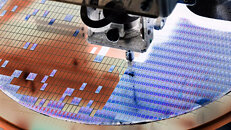Raevenlord
News Editor
- Joined
- Aug 12, 2016
- Messages
- 3,755 (1.18/day)
- Location
- Portugal
| System Name | The Ryzening |
|---|---|
| Processor | AMD Ryzen 9 5900X |
| Motherboard | MSI X570 MAG TOMAHAWK |
| Cooling | Lian Li Galahad 360mm AIO |
| Memory | 32 GB G.Skill Trident Z F4-3733 (4x 8 GB) |
| Video Card(s) | Gigabyte RTX 3070 Ti |
| Storage | Boot: Transcend MTE220S 2TB, Kintson A2000 1TB, Seagate Firewolf Pro 14 TB |
| Display(s) | Acer Nitro VG270UP (1440p 144 Hz IPS) |
| Case | Lian Li O11DX Dynamic White |
| Audio Device(s) | iFi Audio Zen DAC |
| Power Supply | Seasonic Focus+ 750 W |
| Mouse | Cooler Master Masterkeys Lite L |
| Keyboard | Cooler Master Masterkeys Lite L |
| Software | Windows 10 x64 |
UMC has announced plans to invest $3.6 billion in increasing output from its 28 nm manufacturing facilities. This move comes amidst a global semiconductor shortage, and isn't the first time a semiconductor manufacturer "dust off" their older manufacturing processes as a way to remove pressure from more modern silicon manufacturing capabilities. In this case, UMC will be increasing manufacturing output from its 300 mm Fab 12A facility in Tainan, Taiwan.
UMC has entered agreements with some of its clients, who will be paying upfront for expected chip rollout in the future. In exchange, clients will get the benefits of preset pricing (thus avoiding any potential increases arising from increased demand or general price fluctuation), as well as UMC's assurance of certain manufacturing volume allocation towards their needs. Fab 12A currently manufactures 90,000 300 mm wafers per month (wpm). An additional 10,000 wpm is being installed this year and phase six will add another 27,500 wpm to the mix. The mature 28 nm tools will be installed in floors that already feature support for future tooling upgrades to 14 nm. UMC expects to hire around 1,000 additional employees as part of this expansion effort.

View at TechPowerUp Main Site
UMC has entered agreements with some of its clients, who will be paying upfront for expected chip rollout in the future. In exchange, clients will get the benefits of preset pricing (thus avoiding any potential increases arising from increased demand or general price fluctuation), as well as UMC's assurance of certain manufacturing volume allocation towards their needs. Fab 12A currently manufactures 90,000 300 mm wafers per month (wpm). An additional 10,000 wpm is being installed this year and phase six will add another 27,500 wpm to the mix. The mature 28 nm tools will be installed in floors that already feature support for future tooling upgrades to 14 nm. UMC expects to hire around 1,000 additional employees as part of this expansion effort.

View at TechPowerUp Main Site



 )
)

